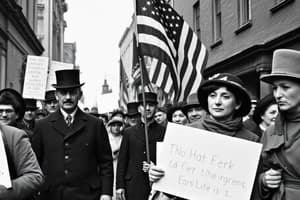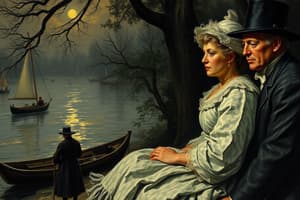Podcast
Questions and Answers
Which of the following best describes the 'Know Nothing Party'’s primary platform during the First Wave (1840-1880)?
Which of the following best describes the 'Know Nothing Party'’s primary platform during the First Wave (1840-1880)?
- Championing westward expansion and land ownership for new settlers, regardless of origin.
- Advocating for expanded immigration rights for all Europeans.
- Promoting policies that favored native-born Americans and were hostile toward immigrants. (correct)
- Supporting the abolition of slavery and equal rights for African Americans.
The Chinese Exclusion Act of 1882 is best understood as a consequence of what broader sentiment prevalent during the First Wave (1840-1880)?
The Chinese Exclusion Act of 1882 is best understood as a consequence of what broader sentiment prevalent during the First Wave (1840-1880)?
- Efforts to improve diplomatic relations and trade partnerships with China.
- A desire to promote cultural diversity and inclusion within American society.
- Growing anti-immigrant sentiment and discriminatory attitudes toward Chinese laborers. (correct)
- Widespread acceptance of Chinese immigrants into the labor force and social fabric.
How did the Irish Potato Famine (1845-1852) most significantly influence immigration patterns during the First Wave (1840-1880)?
How did the Irish Potato Famine (1845-1852) most significantly influence immigration patterns during the First Wave (1840-1880)?
- It caused widespread famine and economic hardship in Ireland, triggering a significant surge in Irish immigration to the United States. (correct)
- It led to a decrease in Irish immigration to the United States due to stricter emigration policies.
- It had minimal impact on immigration trends as most Irish citizens chose to remain in their homeland.
- It diverted Irish immigrants to other European countries, reducing the number arriving in the United States.
How did the Naturalization Act of 1870 affect immigration and citizenship during the First Wave (1840-1880)?
How did the Naturalization Act of 1870 affect immigration and citizenship during the First Wave (1840-1880)?
What core idea did Frederick Douglass promote in his writing, “The Composite Nation” (1867)?
What core idea did Frederick Douglass promote in his writing, “The Composite Nation” (1867)?
How did Dennis Kearney’s “Appeal from California. The Chinese Invasion. Workingmen's Address,” (1878) reflect prevailing attitudes during the First Wave (1840-1880)?
How did Dennis Kearney’s “Appeal from California. The Chinese Invasion. Workingmen's Address,” (1878) reflect prevailing attitudes during the First Wave (1840-1880)?
During the Second Wave & Backlash (1880-1965), what did the term 'birds of passage' commonly refer to?
During the Second Wave & Backlash (1880-1965), what did the term 'birds of passage' commonly refer to?
How did eugenics influence immigration policies during the Second Wave & Backlash (1880-1965)?
How did eugenics influence immigration policies during the Second Wave & Backlash (1880-1965)?
What was the primary outcome of U.S. vs. Wong Kim Ark (1898) in shaping immigration law?
What was the primary outcome of U.S. vs. Wong Kim Ark (1898) in shaping immigration law?
How did the Gentleman's Agreement (1907) between the United States and Japan seek to address immigration concerns?
How did the Gentleman's Agreement (1907) between the United States and Japan seek to address immigration concerns?
What was the main effect of the Naturalization Act of 1917 (Barred Zone Act) on immigration?
What was the main effect of the Naturalization Act of 1917 (Barred Zone Act) on immigration?
How did the Emergency Quota Act of 1921 seek to limit immigration into the United States?
How did the Emergency Quota Act of 1921 seek to limit immigration into the United States?
The Sacco and Vanzetti Trial (1921) is most often cited as an example of what phenomenon during the Second Wave & Backlash (1880-1965)?
The Sacco and Vanzetti Trial (1921) is most often cited as an example of what phenomenon during the Second Wave & Backlash (1880-1965)?
How did the Johnson-Reed Immigration Act of 1924 further shape immigration policy in the United States?
How did the Johnson-Reed Immigration Act of 1924 further shape immigration policy in the United States?
What role did the First Red Scare (1917-1920) play in shaping attitudes towards immigrants during the Second Wave & Backlash (1880-1965)?
What role did the First Red Scare (1917-1920) play in shaping attitudes towards immigrants during the Second Wave & Backlash (1880-1965)?
During the Second Wave (1880-1965), what was the main argument of groups such as the League of United Latin American Citizens (LULAC)?
During the Second Wave (1880-1965), what was the main argument of groups such as the League of United Latin American Citizens (LULAC)?
During the Second Wave & Backlash (1880-1965), how did World War II (U.S. involvement: 1941-1945) affect existing immigration policies and attitudes?
During the Second Wave & Backlash (1880-1965), how did World War II (U.S. involvement: 1941-1945) affect existing immigration policies and attitudes?
What was a significant focus of Madison Grant's book, "Passing of the Great Race" (1916), regarding immigration during the Second Wave & Backlash (1880-1965)?
What was a significant focus of Madison Grant's book, "Passing of the Great Race" (1916), regarding immigration during the Second Wave & Backlash (1880-1965)?
Considering the Naturalization Act of 1917, the Emergency Quota Act of 1921, and the Johnson-Reed Immigration Act of 1924, what was a common underlying goal?
Considering the Naturalization Act of 1917, the Emergency Quota Act of 1921, and the Johnson-Reed Immigration Act of 1924, what was a common underlying goal?
Analyzing the historical context of both the First and Second Waves of immigration, which factor most consistently influenced U.S. immigration policies?
Analyzing the historical context of both the First and Second Waves of immigration, which factor most consistently influenced U.S. immigration policies?
Flashcards
WASP
WASP
White Anglo-Saxon Protestant, a dominant cultural group in the US during the first wave of immigration.
Nativism
Nativism
Belief in the inherent superiority of native-born inhabitants over immigrants.
Xenophobia
Xenophobia
Fear or hatred of foreigners or strangers.
Know-Nothing Party
Know-Nothing Party
Signup and view all the flashcards
Diaspora
Diaspora
Signup and view all the flashcards
Detention
Detention
Signup and view all the flashcards
Deportation
Deportation
Signup and view all the flashcards
Composite Nation
Composite Nation
Signup and view all the flashcards
Irish Potato Famine
Irish Potato Famine
Signup and view all the flashcards
14th Amendment
14th Amendment
Signup and view all the flashcards
Naturalization Act of 1870
Naturalization Act of 1870
Signup and view all the flashcards
Chinese Exclusion Act of 1882
Chinese Exclusion Act of 1882
Signup and view all the flashcards
Anti-Semitism
Anti-Semitism
Signup and view all the flashcards
Franco American
Franco American
Signup and view all the flashcards
Birds of passage
Birds of passage
Signup and view all the flashcards
Quota
Quota
Signup and view all the flashcards
Eugenics
Eugenics
Signup and view all the flashcards
Anarchism
Anarchism
Signup and view all the flashcards
Refugee
Refugee
Signup and view all the flashcards
Study Notes
FIRST WAVE (1840-1880) Terms and Concepts
- White Anglo Saxon Protestant (WASP) refers to the dominant cultural group in America
- Whiteness is a social construct designating privilege based on skin color
- Nativism is the policy of protecting the interests of native-born or established inhabitants against those of immigrants
- Xenophobia is dislike of or prejudice against people from other countries
- The Know-Nothing Party was a nativist political party active in the mid-19th century
- Diaspora is the dispersion of any people from their original homeland
- Detention is the act of detaining someone or something
- Deportation is the expulsion of a person or group of people from a country
- A composite nation is a nation made up of people from different backgrounds
FIRST WAVE (1840-1880) Events and Laws
- The Irish Potato Famine occurred from 1845-1852
- The 14th Amendment to the US Constitution was ratified in 1868
- The Naturalization Act of 1870 addressed who could become a naturalized citizen
- The Chinese Exclusion Act was passed in 1882
FIRST WAVE (1840-1880) Primary Source Readings
- John F. Poole wrote "No Irish Need Apply" in 1862
- Frederick Douglass wrote "The Composite Nation" in 1867
- Dennis Kearney wrote "Appeal from California. The Chinese Invasion. Workingmen’s Address" in 1878
- Fu Chi Hao wrote "My Reception in America," in The Outlook on August 10, 1907
- Angel Island Poetry documents the experiences of immigrants detained at Angel Island
SECOND WAVE & BACKLASH (1880-1965) Terms and Concepts
- Franco American refers to Americans of French descent
- Birds of passage refers to immigrants who temporarily migrate
- Quota refers to a limited number or amount of people or things
- Eugenics is the belief in improving the genetic quality of a human population
- Anarchism is belief in the abolition of all government
- Refuge is being safe or sheltered from pursuit, danger, or trouble
- Refugee is a person who has been forced to leave their country in order to escape war, persecution, or natural disaster
- Anti-Semitism is hostility to or prejudice against Jewish people
SECOND WAVE & BACKLASH (1880-1965) Events and Laws
- US vs. Wong Ark was decided in 1898
- The Gentlemen’s Agreement was in 1907
- The Naturalization Act of 1917 included the Barred Zone Act
- The First Red Scare occurred from 1917-1920
- The Emergency Quota Act was passed in 1921
- The Sacco and Vanzetti Trial occurred in 1921
- Ozawa vs. US was decided in 1922
- Thind vs. US was decided in 1923
- The Johnson-Reed Immigration Act was passed in 1924
- US involvement in World War II lasted from 1941-1945
SECOND WAVE & BACKLASH (1880-1965) Secondary Source Readings
- Ken Burns, Lynn Novick, and Sarah Botsein created, The US and the Holocaust in 2022
- “Citizen Thind,” appeared Scene on Radio Season 2 (“Seeing White”): Episode 10
- City Island, “Flashback,” is available on PBS Kids
- David Vermette wrote “Why Are Franco-Americans So Invisible” French North America on March 31, 2016
SECOND WAVE & BACKLASH (1880-1965) Primary Source Readings
- Emma Lazarus wrote "The New Colossus" in 1883
- Ellis Island, 29 Questions
- John Box wrote “Immigration Restriction” in 1928
- League of United Latin American Citizens (LULAC) wrote “Community Institutions” in 1929
- Madison Grant wrote “Passing of a Great Race” in 1916
Studying That Suits You
Use AI to generate personalized quizzes and flashcards to suit your learning preferences.




